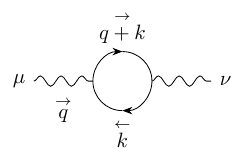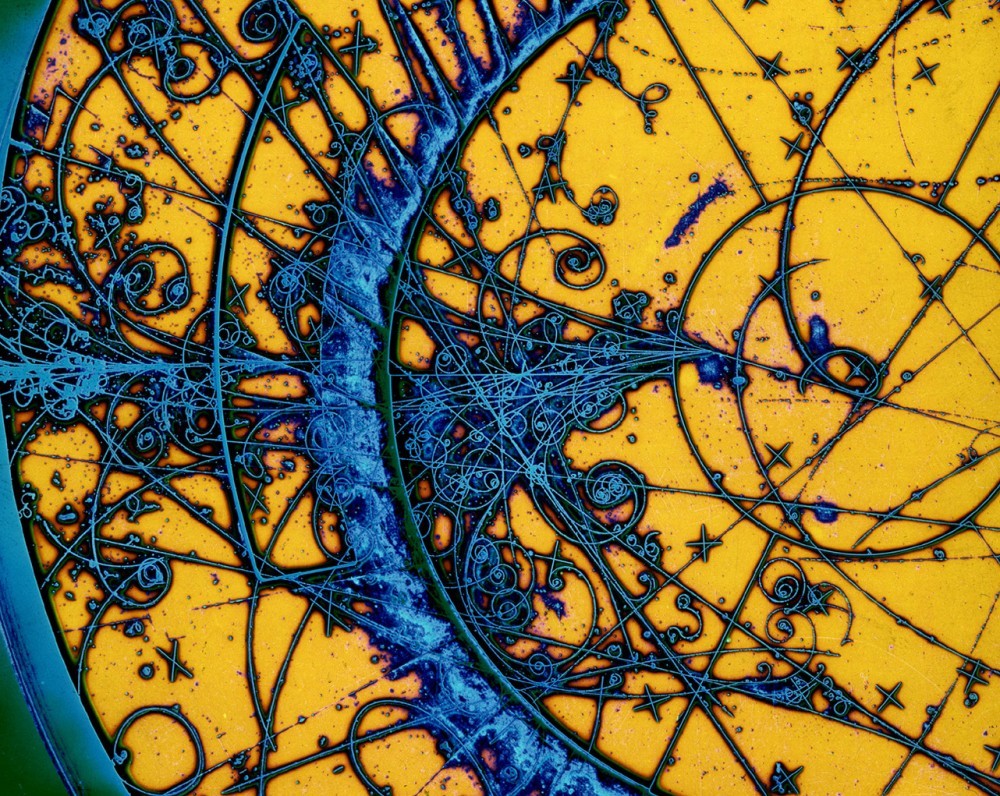QED单圈修正的计算#
Lagrangian#
The renormalized QED Lagrangian we use is as follows:
The renormalized perturbation theory is achieved by splitting the lagrangian above appropriately:
Calculation of photon self-energy diagram#
(*Import Feyncalc*)
<< FeynCalc`
FeynCalc 9.3.1 (stable version). For help, use the documentation center,\
> check out the wiki or visit the forum.
To save your and our time, please check our FAQ
> for answers to some common FeynCalc questions.
See also the supplied examples. If you use FeynCalc in your research, please\
> cite
\[Bullet] V. Shtabovenko, R. Mertig and F. Orellana, Comput.Phys.Commun. 256\
> (2020) 107478, arXiv:2001.04407.
\[Bullet] V. Shtabovenko, R. Mertig and F. Orellana, Comput.Phys.Commun. 207\
> (2016) 432-444, arXiv:1601.01167.
\[Bullet] R. Mertig, M. Bo"hm, and A. Denner, Comput. Phys. Commun. 64\
> (1991) 345-359.
Define the One-Particle-Irreducible (1PI) diagram of the photon self energy as \(i \Pi_{\mu\nu} (q)\). Ward identidy implies:
Which imples that \(\Pi_{\mu\nu}\) can be uniquely decomposed as
We shall check this decomposition from explicit calculation. At one-loop, the Feynman diagram for \(i \Pi_{\mu\nu}(q^2)\) is given by:

From the Feynman rule, we can read off the one-loop diagram as:
Let’s evaulate the trace first. define
We can easily evaulate it in Mathematica with the help of FeynCalc:
num1=-(-I e)^2*I^2*Tr[(GSD[k]+m).GAD[\[Nu]].(GSD[q+k]+m).GAD[\[Mu]]]
We can combine the numerator using Feynman’s parameterization:
This suggest that we should shift the loop momentum as \(l^\mu = k^\mu + x q^\mu\). Applying this momentum shift to the numerator, we get:
(*make a momentum shift k->l - x q*)
FCE[num1]//InputForm
num2=FCE[num1]/.{FVD[k,a_]:>FVD[l,a]-x*FVD[q,a], SPD[k,k]:>SPD[l,l]-2*x*SPD[l,q]+x^2*SPD[q,q], SPD[k,q]:>SPD[l,q]-x*SPD[q,q]}//Expand
Now we can drop all terms linear in \(l\), and replace \(l^\mu l^\nu\) by \(l^2 \eta^{\mu\nu}/d\):
num3=FCE[num2]/.{FVD[l,\[Mu]] FVD[l,\[Nu]]->SPD[l,l]*MTD[\[Mu],\[Nu]]/d}/.{SPD[l,q]:>0}/.{FVD[l,_]:>0}//Collect[#,SPD[l,l],Simplify]&
We now have two different integrals to evaluate:
Substituting the known integrals in \(d\) dimensions:
int1[d_,n_,delta_]:=I*(-1)^n/(4*Pi)^(d/2)*Gamma[n-d/2]/Gamma[n]*delta^(d/2-n);
int2[d_,n_,delta_]:=I*(-1)^(n-1)/(4*Pi)^(d/2)*Gamma[n-d/2-1]/Gamma[n]*delta^(d/2+1-n)*d/2;
Expanding to \({\cal O}(\epsilon)\), the sum of the \(I_1\) and \(I_2\) is now given by (Note that at this step we have adopt the \(\overline{\mathrm{MS}}\) scheme, where the renormalization scale is modified to be \(\mu^2 \to \mu^2 (4 \pi)^{-\epsilon} e^{\epsilon \gamma_E}\)):
sum1=Coefficient[num3,SPD[l,l]]*int2[d,2,Δ]+(num3/.SPD[l,l]->0)*int1[d,2,Δ];
sum2=Series[(4*Pi)^(-eps)*Exp[eps*EulerGamma]*\[Mu]^(2*eps)*sum1/.{d->4-2*eps},{eps,0,0}]//Normal
(*Substitute in the value of Delta*)
myDelta=m^2-x*(1-x)*SPD[q,q];
sum3=sum2/.Δ->myDelta//Simplify//Collect[#,eps]&
(*Perform the x integral*)
sum4=Integrate[sum3,{x,0,1},GenerateConditions->False]
sum5=Collect[sum4/.SPD[q,q]->q^2,eps]//Simplify[#,Assumptions->{q>0}]&//Collect[#,eps]&
(*Let m^2=r*q^2*)
sum6=sum5//Simplify[#,Assumptions->{q>0}]&//Collect[#,eps]&
(*and for q^2->0, this result for Pi(q^2=0) becomes*)
sum7=Coefficient[Series[Coefficient[(-I)*sum6,MTD[\[Mu],\[Nu]]],{q,0,2}]//Normal//Simplify[#,Assumptions->{q>0}]&//Collect[#,eps]&,q^2]/.e^2->alpha*(4*Pi)
Now Let’s consider the Dyson series for the photon self-energy diagram:
The terms proportional to \(q_\mu q_\nu\) vanishes when contracted with a fermion line by Ward identity, therefore can be neglected. We now find that the exact Kallen-Lehmann propagator for photon is given by
where the \(\cdots\) represents the continous spectrum of the photon. We see that the mass of photon is not renormalized in perturbation theory, as it shouldn’t. The renormalization constant \(Z_3\) is therefore given by
Substitute the explicit one-loop result we obtained previously, we found
